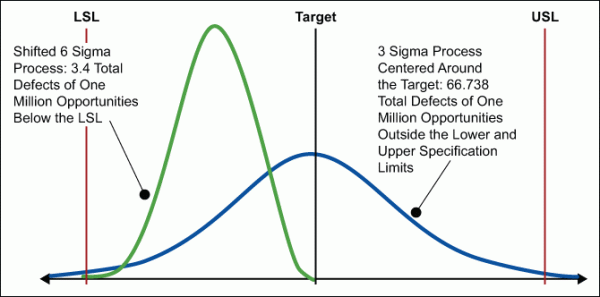
Key Points
- Statistical Six Sigma refers to production quality that reaches near-perfect levels.
- Six Sigma is a complementary calculation to the likes of Cpk and DPMO.
- Understanding how it works will enable your organization to create stable and capable processes.
What does it mean to be “Six Sigma”? Six Sigma at many organizations simply means a measure of quality that strives for near perfection. However, the statistical implications of a Six Sigma program go well beyond the qualitative eradication of customer-perceptible defects. It’s a methodology that is well-rooted in mathematics and statistics.
What It Means
The objective of Six Sigma quality is to reduce process output variation so that on a long-term basis, which is the customer’s aggregate experience with our process over time, this will result in no more than 3.4 defect parts per million (PPM) opportunities (or 3.4 defects per million opportunities – DPMO).
For a process with only one specification limit (upper or lower), this results in six process standard deviations between the mean of the process and the customer’s specification limit (hence, Six Sigma).
For a process with two specification limits (upper and lower), this translates to slightly more than six process standard deviations between the mean and each specification limit such that the total defect rate corresponds to the equivalent of six process standard deviations.

How It Relates to Process Capability
Many processes are prone to be influenced by special and/or assignable causes that impact the overall performance of the process relative to the customer’s specification. That is, the overall performance of our process as the customer views it might be 3.4 DPMO (corresponding to a long-term performance of 4.5 sigma). However, our process could indeed be capable of producing a near-perfect output (Short Term capability – also known as process entitlement – of Six Sigma).
The difference between the “best” process can be, measured by short-term process capability, and the customer’s aggregate experience (long-term capability) is known as Shift depicted as Zshift or sshift. For a “typical” process, the value of shift is 1.5; therefore, when one hears about Six Sigma, inherent in that statement is that the short-term capability of the process is 6, the long-term capability is 4.5 (3.4 DPMO – what the customer sees) with an assumed shift of 1.5.
Calculating Six Sigma
Typically, when reference is given using DPMO, it denotes the long-term capability of the process, which is the customer’s experience. The role of the Six Sigma professional is to quantify the process performance (short-term and long-term capability) and based on the true process entitlement and process shift, establish the right strategy to reach the established performance objective
As the process sigma value increases from zero to six, the variation of the process around the mean value decreases. With a high enough value of process sigma, the process approaches zero variation and is known as ‘zero defects.’
Is Six Sigma Just DPMO?
At first glance, you could be forgiven for thinking this to be the case. Both of these calculations are similar in concept and scope. However, the way you’ll derive them is different. Further, you can interchangeably calculate your statistical Six Sigma from things like your capability indices. All of these come together to let you know just how your processes are performing.
As such, they aren’t monolithic calculations, but rather a way to drill down to see where improvements are needed.
Other Useful Tools and Concepts
Six Sigma is a heady subject, but we’ve got other tidbits to get you started on your journey. You’ll likely come across DMAIC and DFSS while studying Six Sigma, but what do they mean? Our guide nails down how these approaches differ and when to use them.
Further, you might need to know how to calculate your Process Sigma. This directly ties into today’s subject, and you can find everything you need in our short article covering the subject.
Statistical Take Away
Decrease your process variation (remember variance is the square of your process standard deviation) to increase your process sigma. The result is greater customer satisfaction and lower costs.